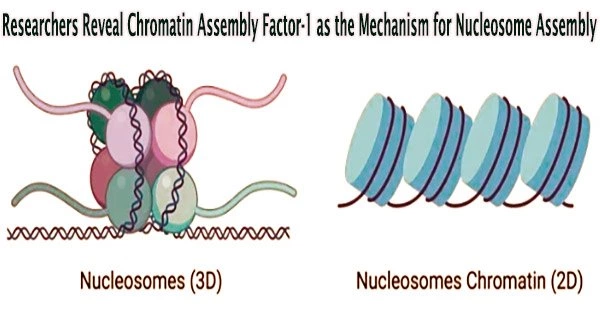Because the passage of the DNA replication fork breaks the nucleosomes on the DNA, chromosome inheritance during cell division requires DNA replication and nucleosome assembly onto the duplicated DNA. The parental nucleosomes that have been disrupted provide half of the histones needed for the replication-coupled nucleosome assembly, and the other half is freshly created.
The placement of freshly generated histones H3 and H4 on DNA is carried out by the heterotrimeric protein complex known as chromatin assembly factor-1 (CAF-1). However, the lack of structural information about CAF-1 has hindered the understanding of the molecular mechanism underlying de novo nucleosome assembly.
In a study published in Science on August 25, 2023, a research team led by Prof. Xu Ruiming from the Institute of Biophysics (IBP) of the Chinese Academy of Sciences, in collaboration with Prof. Li Guohong, Prof. Zhu Bing and Prof. Liu Chaopei, all from IBP, reported high-resolution structures of CAF-1 and CAF-1 bound to histones H3-H4.
The researchers first determined the crystal structure of the core domain of human CAF-1 in the absence of histones and the electron microscopy (cryo-EM) structure of CAF-1 in complex with histones H3 and H4.
The results showed that a CAF-1 complex binds to an H3-H4 heterodimer mainly through the p60 subunit and the ED loop of the p150 subunit.
As determined by correlating the structural data with in vitro histone binding and plasmid supercoiling experiments, in vivo nascent nucleosome assembly mapping, and transcriptome investigations, the C-terminal region of the ED loop is essential to the biological activity of CAF-1.
The researchers also found that a 30-bp DNA oligomer triggers the dimerization of the CAF-1-H3-H4 complex, and solved the cryo-EM structure of a 2:2 CAF-1-H3-H4 complex.
This structure showed that two adjacent H3-H4 heterodimers are poised for the formation of an H3-H4 tetramer via dimerization of two H3s, but the positioning of the two heterodimers are not yet in the exact geometric arrangement of an H3-H4 tetramer, suggesting that a remodeling of histone H3-H4 binding by CAF-1, perhaps with the binding of a longer DNA fragment, is needed to assemble the H3-H4 tetramer which is an essential unit of the nucleosome.
Using a 147-bp DNA fragment, the researchers observed a CAF-1-bound right-handed di-tetrasome structure, which was further confirmed by the analysis using the single-molecule freely orbiting magnetic tweezer (FOMT) method at a physiological salt concentration.
This finding opened up a new avenue for mechanistic research into the nucleosome assembly process and suggested that a right-handed nucleosome precursor may be involved in replication-coupled nucleosome assembly.





